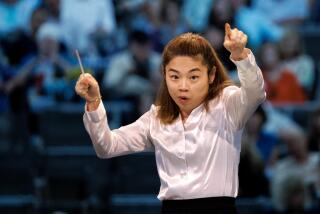MUSIC REVIEW : Takacs Off Form at Ford Amphitheatre
On the occasion of its Monday concert at the John Anson Ford Amphitheatre, one expected of the Takacs String Quartet memorable music-making comparable to that provided there by the Bartok and Emerson Quartets, who have graced the baby Bowl since the Los Angeles Philharmonic was inspired to revive it as a concert venue several seasons ago.
Whether the result of atmospheric conditions--a sultry evening turned bone-chilling--a long season of touring or the subtler ravages wrought by recently achieved fame, the Hungarian ensemble, now in residence at the University of Colorado, was off form.
When last heard locally, the then up-and-coming Takacs displayed probing interpretive skills and clean, balanced, middleweight ensemble tone. Monday’s internationally lionized group, its personnel unchanged, was a less ingratiating entity.
Beginning with anything as subtle and exposed as Mozart’s Quartet in F, K. 590, is ill-advised, particularly in the sound-dissipating out of doors.
The Takacs’ Mozart--stylishly mobile in past encounters--proved lumpy and ill-balanced, with squally tone from first violinist Gabor Takacs-Nagy and instances of inner-voice inaudibility, the dropouts being normally assertive second violinist Karoly Schranz and violist Gabor Ormai.
Only cellist Andras Fejer, maintaining firm tone and solid rhythmicality, seemed fully engaged.
Two spectacularly ill-timed helicopter overflights applied the coup de grace to the otherworldly calm that Mozart went to such pains to convey in his valedictory quartet.
Since their inception in the mid-’70s, the Takacs has impressed with its Bartok interpretations, a reasoned alternative to the slashing, bared-fang methods once considered appropriate to projecting the composer’s intensity.
On Monday, in the outer movements of his Fourth Quartet, it was bad old Bartok, his detailing steamrollered by heavy bow pressure, stridency and hyper-aggressiveness.
The creepy, magically colored central nocturne was, however, spun out with utmost subtlety and clarity of individual voices: the Takacs of old at its most potent.
As a parting gesture, Schubert’s “Death and the Maiden” Quartet began sluggishly, with the first violinist frequently under pitch.
The remembered Takacs sweetness of tone--one has to assume that Monday was an aberration--resurfaced in a graceful slow movement during which, however, the sublime opening of the cello variation was obliterated by another of those filthy flying machines.
It was enough to bring out the latent blood lust of the most dedicated pacifist.
More to Read
The biggest entertainment stories
Get our big stories about Hollywood, film, television, music, arts, culture and more right in your inbox as soon as they publish.
You may occasionally receive promotional content from the Los Angeles Times.










